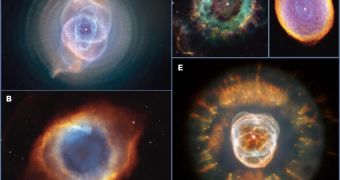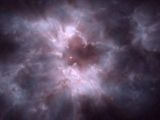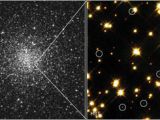The Sun is now in a dynamic equilibrium - there is gravity on one hand and the fusion process that "fuels" the Sun on the other hand. Gravitation condenses the matter but as atoms (especially hydrogen) are squished together, they fuse into heavier atoms (helium) releasing a lot of energy in the process. This release of energy balances the gravitation. But this will go on only as long as there is enough "fuel". Eventually, all the hydrogen would have been transformed into helium (in about 5 billion years) and the helium will by transformed into carbon. A star like the Sun is not massive enough to be capable of fusing carbon.
Astronomers still don't know all the exact details but they know that the Sun will start to swell into a red giant that would reach a diameter about 100 times greater than its current size (it will probably engulf Earth). The image shows a comparison between red giants and the Sun (the small dot).
In the aftermath of the red giant there will remain a white dwarf in the middle. The dissipating gas bubble continues to glow due to the ultraviolet radiation shooting from the interior. This glowing gas, called planetary nebulae, will eventually disperse in several thousand years leaving behind the white dwarf.
The planetary nebulae
Astronomers have observed many Sun-like stars in their final stages, before becoming white dwarfs. The images of planetary nebulae are spectacular and each looks like none other. The expelled gas has intriguing symmetrical patterns as well as more chaotic structures.
Scientists are baffled by how a spherical star produces such prominent, non-spherical symmetries in the gas that it ejects. Some have suggested that the shapes might be influenced by the magnetic fields generated by the star. The shapes might also be influenced by the gravitation of other nearby stars.
The image below shows a sampling of nebulae imaged by the Hubble Space Telescope: Cat's Eye nebula (A), Helix Nebula (B), Little Ghost Nebula (C), Spirograph Nebula (D), and Eskimo Nebula (E).
Credits: Cat's Eye nebulae: R. Corradi (Isaac Newton Group of Telescopes, Spain), Z. Tsvetanov (NASA). Helix Nebula: NASA, ESA, C.R. O'Dell (Vanderbilt University), and M. Meixner, P. McCullough (STScI); Little Ghost and Spirograph Nebulae: NASA and The Hubble Heritage Team (STScI/AURA); Eskimo Nebula: NASA, A. Fruchter, and the ERO Team (STScI).
The Cat's Eye nebula (A) has a pattern of 11 or more concentric rings, or shells. Each shell is the edge of a spherical bubble. The star seems to have had episodic "eruptions" of gas recurring about every 1,500 years. Astronomers have seen such concentric rings around other planetary nebulae as well.
The Helix nebula (B) bears this name because astronomers think it is shaped like a tube (we're looking straight into it). However, this tube is rather short, more like a ring: it has a length of about 0.2 light years (about one trillion kilometers) and a diameter of around 2.5 light years.
The white and orange "tentacles" that make this ring seem to float on a blue gas. These filaments were probably ejected by the dying star and formed comet-like trails of colder dust and gas.
The Helix, located 650 light years from Earth, is one of the closest planetary nebulae. This glowing gas cloud appears very large in the sky: about half the diameter of the full moon.
The Eskimo nebula (E) began forming about 10,000 years ago, when the dying star started to throw material into space. Astronomers think it is made of two elliptically-shaped lobes of matter streaming away from the dying star but from our perspective, one bubble lies in front of the other, obscuring part of the second lobe. The bubbles are not smooth like balloons, but rather have filaments of denser matter. Each bubble is roughly one light-year long and half a light-year wide.
The red and orange ring of material still puzzles scientists. Some think that it has formed from a collision of slow- and fast-moving gases.
Each of these planetary nebulae has a white dwarf in the middle (the bright dot near the center). One of the hottest white dwarf stars known is in the planetary nebula designated NGC 2440 (shown in this image). (Credit: H. Bond (STSci), R. Ciardullo (PSU), WFPC2, HST, NASA)
The white dwarf
The white dwarf that remains behind the vanishing planetary nebula does not collapse entirely because its gravitation is balanced by the electric repulsion between the electrons inside it. If the initial star would be larger, the star would collapse even further forming a neutron star - which stops from collapsing due to the nuclear force between the neutrons (an even larger star collapses into a black hole). The white dwarf is still a gaseous object, while neutron stars are probably liquid.
A white dwarf as massive as the Sun is roughly the same size as the Earth. They are so dense that a teaspoon of white dwarf material would weigh several tones. The gravity at the surface of the white dwarf is over 100,000 times what we experience on Earth!
Once the white dwarf has reached its minimum size, it has a temperature of over 100,000 Kelvin and it shines through residual heat. The star will gradually cool and eventually, after hundreds of billions of years of radiating, it will no longer be visible, becoming a black dwarf. Because the Universe is only 13.7 billion years old, there are no black dwarfs yet.
Sirius B was the first white dwarf discovered in 1862. This is an X-ray image taken by Chandra. The bright source is Sirius B shining in low-energy X-rays at a temperature of approximately 25,000 degrees Kelvin. Sirius A (a normal star twice as massive as the Sun) is the faint source to the upper right. In an optical image, Sirius A would appear 10,000 times brighter than Sirius B. Credit: NASA/CXC/SAO
This image shows many white dwarfs in the globular cluster M4 (they are much fainter than the dominant red and yellow stars). Astronomers think this cluster contains about 40,000 white dwarfs. Credit: Harvey Richer (University of British Columbia, Vancouver)/NASA/NSSDC
Scientists are interested in the study of the demise of Sun-like stars not only because our Sun will end like that, but also because two of the elements critical to life (carbon and nitrogen) are formed inside red giants and eventually expelled into interstellar space when the planetary nebulae disperse. Eventually, these elements are brought together again by gravitation and enter the composition of new stars and planets.

 14 DAY TRIAL //
14 DAY TRIAL // 



